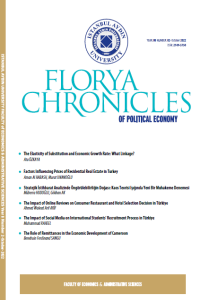Öz
We reconsider the effect of elasticity of substitution on: income per-capita, growth rate of capital-labor ratio, growth rate of income per-capita, the steady-state capital-labor ratio and the steady-state income per-capita, respectively. We demonstrate that: first, both income per-capita and growth rate of capital-labor ratio are decreasing functions of elasticity of substitution. Second, we find out that an increase in substitution elasticity leads to an increase or a decrease in the growth rate of income per-capita depending on initial-terminal conditions of the production function. Moreover, we demonstrate that at steady-state an increase in elasticity of substitution decreases both growth rate of capital-labor ratio and growth rate of income per- capita. Finally, we revise the erroneous result that there is a threshold of elasticity of substitution for which there is no steady-state equilibrium and for which ever-sustained growth is entailed. Instead, as a policy instrument increasing the minimum marginal product of labor is demonstrated to increase the growth rate of income per-capita.
Anahtar Kelimeler
Economic Growth Constant Elasticity of Substitution Production Function Dynamical Equilibrium Steady-State Growth Rate
Kaynakça
- Arrow, K.J., Chenery, H.B., Minhas, B.S. and Solow, R.M. (1961). Capital-Labor Substitution and Economic Efficiency. The Review of Economics and Statistics, Vol. 43, No. 3, 225-250
- De La Grandville, O. (1989). In Quest of the Slutsky Diamond. The American Economic Review, Vol. 79, No. 3, 468-481
- De La Grandville, O. (2009). Economic growth: a unified approach. (Cambridge University Press)
- De La Grandville, O. and Solow, R. M. (2006). A conjecture on general means. Journal of Inequalities in Pure and Applied Mathematics, 7(3).
- De La Grandville, O. and Solow, R. M. (2009). Capital-labour substitution and economic growth. In Economic Growth: A Unified Approach. (Cambridge University Press)
- Klump, R. and de La Grandville, O. (2000). Economic Growth and Elasticity of Substitution: Two Theorems and Some Suggestions. The American Economic Review, 90, 282-291.
- Klump, R. and Preissler, H. (2000). CES Production Functions and Economic Growth. Scandinavian Journal of Economics, 102, (1), 41-56.
- Klump, R. and de La Grandville, O. (2000). Economic Growth and Elasticity of Substitution: Two Theorems and Some Suggestions. The American Economic Review, 90 (2000), 282-291.
- Solow, R.M. (1956). A Contribution to the Theory of Economic Growth. The Quarterly Journal of Economics, 70, no. 1, 65-94.
Öz
Kaynakça
- Arrow, K.J., Chenery, H.B., Minhas, B.S. and Solow, R.M. (1961). Capital-Labor Substitution and Economic Efficiency. The Review of Economics and Statistics, Vol. 43, No. 3, 225-250
- De La Grandville, O. (1989). In Quest of the Slutsky Diamond. The American Economic Review, Vol. 79, No. 3, 468-481
- De La Grandville, O. (2009). Economic growth: a unified approach. (Cambridge University Press)
- De La Grandville, O. and Solow, R. M. (2006). A conjecture on general means. Journal of Inequalities in Pure and Applied Mathematics, 7(3).
- De La Grandville, O. and Solow, R. M. (2009). Capital-labour substitution and economic growth. In Economic Growth: A Unified Approach. (Cambridge University Press)
- Klump, R. and de La Grandville, O. (2000). Economic Growth and Elasticity of Substitution: Two Theorems and Some Suggestions. The American Economic Review, 90, 282-291.
- Klump, R. and Preissler, H. (2000). CES Production Functions and Economic Growth. Scandinavian Journal of Economics, 102, (1), 41-56.
- Klump, R. and de La Grandville, O. (2000). Economic Growth and Elasticity of Substitution: Two Theorems and Some Suggestions. The American Economic Review, 90 (2000), 282-291.
- Solow, R.M. (1956). A Contribution to the Theory of Economic Growth. The Quarterly Journal of Economics, 70, no. 1, 65-94.
Ayrıntılar
| Birincil Dil | İngilizce |
|---|---|
| Konular | Ekonomi |
| Bölüm | Araştırma Makalesi |
| Yazarlar | |
| Erken Görünüm Tarihi | 6 Ekim 2022 |
| Yayımlanma Tarihi | 6 Ekim 2022 |
| Yayımlandığı Sayı | Yıl 2022 Cilt: 8 Sayı: 2 |

